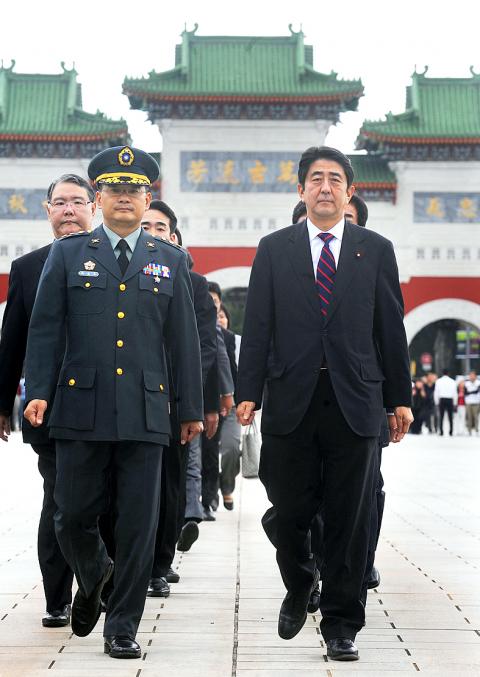|
Former Japanese PM Abe visits Taiwan,
meets Ma
By Ko Shu-ling / Staff Reporter

Former Japanese prime minister Shinzo Abe,
right, pays his respects at the Martyr’s Shrine in Taipei yesterday.
PHOTO: LIAO CHEN-HUEI, TAIPEI TIMES
President Ma Ying-jeou (馬英九) yesterday shunned issues relating to the contested
Diaoyutai Islands (釣魚台) during his meeting with former Japanese prime minister
Shinzo Abe.
Abe arrived in Taipei yesterday on the inaugural flight from Tokyo’s Haneda
Airport to Taipei International Airport (Songshan). Eyes were on his meeting
with Ma and whether they would touch on issues related to the island chain in
the East China Sea claimed by China, Taiwan and Japan.
During a trip to the US earlier last month, Abe used a Nazi-era term to accuse
China of pursing a modern-day policy of lebensraum with its growing
assertiveness over disputed territories.
Lebensraum, or “living space,” was a key tenet in the philosophy of Adolf Hitler
who believed that Germany deserved space, especially in eastern Slavic areas, in
which to grow.
Beijing and Tokyo have been embroiled in a bruising diplomatic row since early
September, when Japanese authorities arrested the captain of a fishing trawler
near the islets known as Diaoyutais in Taiwan and China and Senkaku in Japan.
The Ma government said earlier this month that there was no need to object to
China’s territorial claim to the -Diaoyutais since the -Republic of China (ROC)
-Constitution states that China is still considered a territory of the ROC on
Taiwan. This prompted concerns from Japanese officials over the political
implications of this interpretation.
Ma avoided the contentious issue yesterday and instead focused on the resumption
of direct flights between Taipei and Tokyo.
Describing Abe as “the ROC’s best friend,” Ma said Abe was the third generation
of his family to have close ties with the ROC.
The resumption of flights between Songshan and Haneda was an important
indication of improved Taiwan-Japan relations over the past two years, Ma said.
Aside from paying a visit to former president Lee Teng-hui (李登輝), Abe also
visited the Martyrs’ Shrine (忠烈祠) where people who died in the state’s service
are enshrined.
When asked by the press why he chose to pay a visit to the shrine, Abe said
through a translator that people who sacrificed their lives for their country
all deserved to be honored. When further pressed by the reporters whether he
knew the shrine also honored anti-Japan martyrs, Abe did not answer as the
accompanied translator did not translate the question.
Lee affirmed Abe’s shrine visit, saying it was a show of respect for the
country.
|
![]()
![]()
![]()